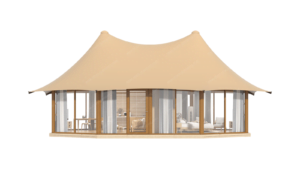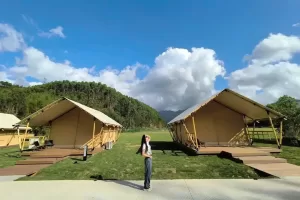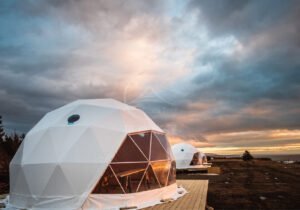giriiş
Buying a safari çadırı is a significant investment, especially for those who love the great outdoors and seek comfort while camping. Safari tents are not just ordinary camping tents; they offer a blend of luxury and practicality, making them ideal for glamping, extended camping trips, and eco-tourism. With numerous options on the market, it can be challenging to choose the right one that meets your needs. This guide will walk you through all the crucial factors to consider when buying a safari tent, ensuring you make a well-informed decision that suits your adventure style.

Understanding Safari Tents
What is a Safari Tent? A safari tent is a large, durable tent designed for extended outdoor stays, often used in glamping resorts and eco-friendly lodges. Unlike typical camping tents, safari tents are built to provide a more comfortable and luxurious experience, often featuring separate sleeping and living areas, sturdy construction, and weather-resistant materials. Originally inspired by the tents used on African safaris, these structures have evolved to become a popular choice for those looking to combine the beauty of nature with the comforts of home.
Common Uses: Glamping, Extended Camping, Eco-Tourism Safari tents are versatile and can be used in various settings. For glamping, they provide a high-end camping experience with amenities such as real beds, furniture, and sometimes even plumbing and electricity. For extended camping trips, they offer more space and durability compared to standard tents, making them ideal for long-term stays in the wilderness. Additionally, safari tents are commonly used in eco-tourism, providing sustainable and comfortable accommodations that blend seamlessly with natural surroundings.
The Appeal of Safari Tents: Luxury and Durability What sets safari tents apart is their ability to offer both luxury and durability. With their spacious interiors and high ceilings, they allow for a comfortable living environment even in the wild. The use of high-quality materials ensures that these tents can withstand harsh weather conditions, providing reliable shelter in diverse climates. Whether you’re looking for a temporary getaway or a semi-permanent structure, a safari tent offers a unique combination of ruggedness and comfort.

Material and Construction
Types of Materials Used in Safari Tents When choosing a safari tent, the material is one of the most critical factors to consider. The most common materials used are canvas and polycotton, each offering different benefits. Canvas is known for its breathability and insulation, making it suitable for various climates. It is also highly durable and resistant to wear and tear. Polycotton, a blend of polyester and cotton, combines the strength of synthetic fibers with the breathability of cotton, offering a lighter yet equally durable option. Both materials are treated to be water-resistant and mold-resistant, ensuring longevity.
Frame Materials: Steel vs. Aluminum The frame of a safari tent is just as important as the fabric. Most safari tents are supported by either steel or aluminum frames. Steel frames are known for their strength and stability, making them ideal for larger tents or areas prone to strong winds. However, they are heavier and less portable than aluminum frames. Aluminum, on the other hand, is lightweight and resistant to corrosion, making it easier to transport and set up. The choice between steel and aluminum will depend on your priorities, such as portability versus stability.
Weather Resistance and Durability A safari tent’s ability to withstand various weather conditions is crucial, especially if you plan to use it in different environments. Look for tents with reinforced seams, waterproof coatings, and UV-resistant materials. A durable safari tent will not only protect you from rain and sun but also offer resistance to wind and pests. The thickness of the canvas or polycotton material also plays a role in its durability, with heavier materials providing better insulation and protection.
Importance of Proper Ventilation Ventilation is a key factor in ensuring comfort inside a safari tent. Good ventilation prevents condensation buildup, which can lead to dampness and mold. Look for tents with multiple windows, mesh panels, and ventilation flaps that allow for airflow while keeping insects out. Some safari tents also feature roof vents that release hot air, keeping the interior cool during warmer months. Proper ventilation will enhance your overall comfort, making your camping experience more enjoyable.

Size and Space Considerations
Determining the Right Size Based on Your Needs One of the first decisions you need to make is the size of the safari tent. This will depend on the number of occupants and the amount of space you require. Safari tents come in various sizes, ranging from small two-person tents to large family-sized models that can accommodate six or more people. Consider how much room you need for sleeping, storing gear, and moving around comfortably. If you plan to use the tent for glamping, you might want to opt for a larger size that allows for additional furniture and amenities.
Number of Occupants vs. Available Space It’s essential to choose a tent that not only fits the number of people but also provides enough space for everyone to sleep comfortably and store their belongings. The tent’s floor plan should include sufficient space for beds, luggage, and any additional furniture you plan to use. Keep in mind that a tent’s stated capacity might only reflect the number of people it can sleep, not the space required for living and storage. If you prefer more space, consider choosing a tent with a higher capacity than the number of people who will use it.
Layout Options and Room Divisions Some safari tents offer multiple room divisions, which can be a great feature if you value privacy or need separate areas for sleeping and living. Tents with separate sleeping quarters and living spaces allow for better organization and comfort. Look for tents with built-in partitions or the option to add room dividers. This flexibility can make your camping experience more enjoyable, especially if you’re camping with family or a group.
Portability and Storage While safari tents are generally more substantial and less portable than traditional camping tents, some models are designed with ease of transport in mind. Consider the weight of the tent and how easily it can be packed down and stored. If you plan to move your tent frequently, look for a model that comes with a carry bag or storage case, and check the packed dimensions to ensure it will fit in your vehicle. Portability is less of an issue for semi-permanent setups but is crucial for mobile camping.
Design Features to Look For
Types of Entrances and Windows The design of entrances and windows can significantly impact the functionality and comfort of your safari tent. Look for tents with large, zippered entrances that allow easy access and can be secured against insects and weather. Multiple entrances can also be convenient, especially for larger tents. Windows should be well-placed to allow natural light and ventilation while maintaining privacy. Mesh screens are essential for keeping bugs out while letting fresh air in.
Flooring Options: Integrated vs. Detachable Safari tents typically come with either integrated or detachable flooring. Integrated flooring provides better protection against moisture, insects, and cold air, creating a more comfortable living environment. Detachable flooring, on the other hand, offers flexibility and is easier to clean. Consider the conditions in which you’ll be using the tent and choose the flooring option that best suits your needs. Some tents also offer raised flooring, which can be beneficial in wet or uneven terrain.
Additional Features: Porches, Awnings, and Verandas Many safari tents come with additional features like porches, awnings, and verandas, which can enhance your camping experience. A porch or awning provides extra outdoor living space, offering shade and protection from the elements. Verandas can serve as a relaxing outdoor area where you can enjoy the surroundings without being directly exposed to the sun or rain. These features not only add to the tent’s functionality but also create a more homelike atmosphere.
Interior Amenities: Electrical Fittings, Furniture Compatibility If you’re planning to use your safari tent for glamping, consider models that include interior amenities such as electrical fittings for lighting and charging devices. Some tents are designed to accommodate specific types of furniture, making it easier to create a comfortable living space. Look for tents with sturdy internal frames that can support hanging lights, shelves, or even a ceiling fan. These amenities can greatly enhance your comfort and convenience while camping.

Setting Up and Maintaining Your Safari Tent
Ease of Setup: What to Expect Setting up a safari tent can be more complex than pitching a standard camping tent, especially due to its size and weight. However, many modern safari tents are designed for easier assembly, with color-coded poles, clear instructions, and fewer components. Some models even come with quick-setup frames that significantly reduce the time and effort required. Before purchasing, review the setup process to ensure it aligns with your capabilities. If you plan to move the tent frequently, ease of setup will be a critical factor.
Maintenance Tips for Longevity Proper maintenance is essential to extend the life of your safari tent. Regularly cleaning the tent, especially after use in harsh conditions, will prevent mold, mildew, and dirt buildup. If your tent is made of canvas, ensure it is thoroughly dried before storage to avoid mold. Periodically check the seams, zippers, and poles for signs of wear and tear, and repair any damage promptly. Applying a waterproofing treatment once a year can also help maintain the tent’s weather resistance.
Seasonal Care: Handling Weather Extremes Safari tents are built to withstand various weather conditions, but extra care is needed in extreme climates. In hot weather, ensure the tent is well-ventilated and consider using a reflective cover to reduce heat buildup. During cold or wet seasons, make sure the tent is properly sealed and consider using a stove or heater designed for use in tents. If you plan to leave the tent set up for extended periods, check it regularly to ensure it is holding up well against the elements.
Price vs. Quality
Understanding Price Ranges for Safari Tents Safari tents vary widely in price, depending on their size, material, and features. Budget models may start at around $500, while high-end models can exceed $5,000. Understanding what you’re paying for is crucial—higher prices often reflect better materials, greater durability, and additional features. However, a higher price doesn’t always mean better quality, so it’s important to compare the tent’s specifications and customer reviews before making a decision.
Balancing Cost with Features and Durability When purchasing a safari tent, it’s essential to balance cost with the features and durability you need. If you plan to use the tent frequently or in harsh conditions, investing in a more expensive model with high-quality materials and additional features may be worthwhile. On the other hand, if you’re only using the tent occasionally or in mild conditions, a budget-friendly option might suffice. Consider the long-term value of the tent and how well it meets your specific requirements.
When to Invest in Higher-End Models Higher-end safari tents offer several advantages, such as enhanced durability, better weather resistance, and more luxurious features. If you’re using the tent for glamping or in a professional setting, such as an eco-tourism business, it’s worth investing in a top-tier model. These tents are designed to provide comfort and withstand frequent use over many years, making them a good investment for serious outdoor enthusiasts or business owners.
Where to Buy Safari Tents
Online Marketplaces vs. Specialty Stores When buying a safari tent, you can choose between online marketplaces and specialty outdoor stores. Online platforms like Amazon and eBay offer a wide selection of tents at competitive prices, often with customer reviews that can help guide your decision. However, specialty stores may provide better customer service, expert advice, and the opportunity to see the tent in person before buying. Weigh the pros and cons of each option based on your preferences and needs.
Tips for Finding the Best Deals To find the best deals on safari tents, consider shopping during off-season sales or looking for discounts from retailers clearing out old inventory. Subscribe to newsletters from outdoor stores to receive notifications about promotions and special offers. Additionally, compare prices across multiple retailers, both online and in-store, to ensure you’re getting the best deal. Don’t forget to factor in shipping costs, especially for larger tents that may incur higher delivery fees.
Warranty and Return Policies Before purchasing a safari tent, check the warranty and return policies. A good warranty will cover defects in materials and workmanship, giving you peace of mind that your investment is protected. Some manufacturers offer extended warranties, which can be particularly valuable for higher-end models. Understanding the return policy is also important, especially if you’re buying online, as you may want to return or exchange the tent if it doesn’t meet your expectations.

Final Considerations
Recap of Key Points Buying a safari tent involves considering various factors, from the materials and size to the design features and price. By understanding these elements and how they align with your needs, you can make a more informed decision and choose a tent that will provide comfort, durability, and value for your money.
How to Make a Final Decision Based on Your Specific Needs To finalize your decision, consider your primary use for the tent, the typical conditions you’ll face, and your budget. Make a list of the features that are most important to you, and compare different models against this list. If possible, seek out customer reviews or ask for recommendations from experienced campers or glampers. Your final choice should reflect both your personal preferences and practical needs.
Encouragement to Invest Wisely for Long-Term Satisfaction A safari tent is a long-term investment, so take the time to choose wisely. Whether you’re using it for personal adventures or as part of a business, a well-chosen safari tent will enhance your outdoor experience and provide lasting satisfaction. Don’t rush the decision—consider all factors, ask questions, and invest in a tent that will serve you well for years to come.
Çözüm
Buying a safari tent is an exciting opportunity to elevate your outdoor experiences, combining the thrill of camping with the comforts of home. By considering the factors discussed in this guide—such as material quality, size, design features, and price—you can confidently choose a safari tent that meets your needs and enhances your adventures. Whether you’re a seasoned camper or new to glamping, the right safari tent will make your time in nature more enjoyable and memorable. Ready to find your perfect safari tent? Start your search today and invest in a tent that will bring you years of comfort and adventure.




